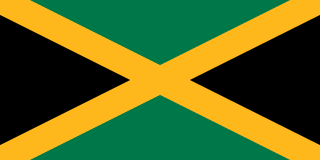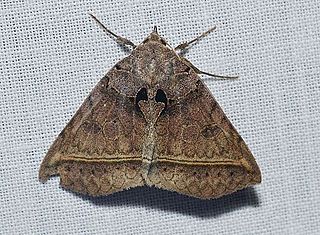
Jamaica is an island country situated in the Caribbean Sea. Spanning 10,990 square kilometres (4,240 sq mi) in area, it is the third-largest island of the Greater Antilles and the Caribbean. Jamaica lies about 145 kilometres (90 mi) south of Cuba, and 191 kilometres (119 mi) west of Hispaniola ; the British Overseas Territory of the Cayman Islands lies some 215 kilometres (134 mi) to the north-west.

The Arctiinae are a large and diverse subfamily of moths, with around 11,000 species found all over the world, including 6,000 neotropical species. This group includes the groups commonly known as tiger moths, which usually have bright colours, footmen, which are usually much drabber, lichen moths, and wasp moths. Many species have "hairy" caterpillars that are popularly known as woolly bears or woolly worms. The scientific name of this subfamily refers to this hairiness. Some species within the Arctiinae have the word tussock in their common name due to people misidentifying them as members of the Lymantriinae based on the characteristics of the larvae.

The erebid moth Ascalapha odorata, commonly known as the black witch, is a large bat-shaped, dark-colored nocturnal moth, ranging from the southern United States to Argentina. It is the largest noctuid in the continental United States. In the folklore of many Central American cultures, it is associated with death or misfortune.

The Dalceridae are a small family of zygaenoid moths with some 80 known species encompassing about one dozen genera mostly found in the Neotropical region with a few reaching the far south of the Nearctic region.

Celiptera is a genus of moths in the family Erebidae.

Celiptera frustulum, the black bit moth, is a moth of the family Erebidae. It is found in eastern North America, as far north as Ontario.
Celiptera valina is a moth of the family Erebidae. It is found in North America, including Texas and Arizona.
William Schaus was an American entomologist who became known for his major contribution to the knowledge and description of new species of the Neotropical Lepidoptera.
Jocara majuscula is a species of snout moth in the genus Jocara. It was described by Gottlieb August Wilhelm Herrich-Schäffer in 1871, and it is found in California, Florida, Central America, Cuba, Puerto Rico and Jamaica.

The Euclidiini are a tribe of moths in the family Erebidae. The tribe was erected by Achille Guenée in 1852.
Celiptera codo is a moth of the family Erebidae. It is found in Mexico (Puebla).
Celiptera guerreronis is a moth of the family Erebidae. It is found on Mexico (Guerrero).
Celiptera grisescens is a moth of the family Erebidae. It is found in Mexico (Veracruz).
Celiptera levinum is a moth of the family Erebidae. It is found in Surinam, Colombia, Brazil, Haiti, the Dominican Republic and Cuba.
Celiptera remigioides is a moth of the family Erebidae. It is found from Mexico (Veracruz) to Brazil, Ecuador and the Galapagos Islands.
Celiptera teretilinea is a moth of the family Erebidae. It is found in southern Brazil.
Celiptera thericles is a moth of the family Erebidae. It is found in French Guiana.
Celiptera carbonensis is a moth of the family Erebidae. It is found in Peru.
Celiptera virginiae is a moth of the family Erebidae. It is found in Bolivia.
Black moth or Black Moth can refer to:







